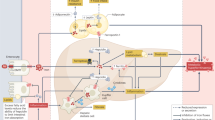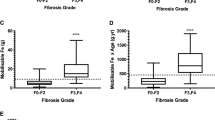Abstract
Hyperferritinemia is common in individuals with the metabolic syndrome (dysmetabolic hyperferritinemia), but its pathophysiology and the degree to which it reflects tissue iron overload remains unclear. We conducted a cross-sectional study evaluating ten cases with dysmetabolic hyperferritinemia for liver iron overload and compared their serum iron indices and urine hepcidin levels to healthy controls. Seven out of ten cases had mild hepatic iron overload by magnetic resonance imaging (MRI) (median, 75 μmol/g dry weight). Cases had higher serum ferritin than controls (median, 672 μg/L vs. 105 μg/L, p < 0.001), but the median transferrin saturation was not significantly different (38% vs. 36%, p = 0.5). Urinary hepcidin was elevated in dysmetabolic hyperferritinemia (median; 1,584 ng/mg of creatinine vs. 799 ng/mg of creatinine, p = 0.05). Dysmetabolic hyperferritinemia is characterized by hyperferritinemia with normal transferrin saturation, elevated hepcidin levels, and mild liver iron overload in a subset of patients.
Similar content being viewed by others
References
Mendler MH, Turlin B, Moirand R, Jouanolle A, Sapey T, Guyader D, Le Gall J, Brissot P, David V, Deugnier Y (1999) Insulin resistance-associated hepatic iron overload. Gastroenterology 117:1155–1163
Riva A, Trombini P, Mariani R, Salvioni A, Coletti S, Bonfadini S, Paolini V, Pozzi M, Facchetti R, Bovo G, Piperno A (2008) Revaluation of clinical and histological criteria for diagnosis of dysmetabolic iron overload syndrome. World J Gastroenterol 14:4745–4752
Brissot P, de Bels F (2006) Current approaches to the management of hemochromatosis. Hematology Am Soc Hematol Educ Program 36–41
Barisani D, Pelucchi S, Mariani R, Galimbert S, Trombini P, Fumagalli D, Meneveri R, Nemeth E, Ganz T, Piperno A (2008) Hepcidin and iron-related gene expression in subjects with dysmetabolic hepatic iron overload. J Hepatol 49:123–133
Turlin B, Mendler MH, Moirand R, Guyader D, Guillygomarc’h A, Deugnier Y (2001) Histologic features of the liver in insulin-resistance-associated iron overload. Am J Clin Pathol 116:263–270
Bozzini C, Girelli D, Olivieri O, Martinelli N, Bassi A, De Matteis G, Tenuti I, Lotto V, Friso S, Pizzolo F, Corrocher R (2005) Prevalence of body iron excess in the metabolic syndrome. Diab Care 28:2061–2063
Alberti KG, Zimmet P, Shaw J (2005) The metabolic syndrome—a new worldwide definition. Lancet 366:1059–1062
Gandon Y, Olivie D, Guyader D, Aube C, Oberti F, Sebille V, Deugnier Y (2004) Non-invasive assessment of hepatic iron stores by MRI. Lancet 363:357–362
Brudevold R, Hole T, Hammerstrom J (2008) Hyperferritinemia is associated with insulin resistance and fatty liver in patients without iron overload. PLoS One 3:e347
Deugnier Y, Turlin B (2007) Pathology of hepatic iron overload. World J Gastroenterol 13:4755–4760
Ruivard M, Laine F, Ganz T, Olbina G, Westerman M, Nemeth E, Rambeau M, Mazur A, Gerbaud L, Tournilhac V, Abergel A, Philippe P, Deugnier Y, Coudray C (2009) Iron absorption in dysmetabolic iron overload syndrome is decreased and correlates with increased plasma hepcidin. J Hepatol 50:1219–1225
De Domenico I, McVey Ward D, Musci G, Kaplan J (2006) Iron overload due to mutations in ferroportin. Haematologica 91:92–95
Aigner E, Theurl I, Theurl M, Lederer D, Haufe H, Dietze O, Strasser M, Datz C, Weiss G (2008) Pathways underlying iron accumulation in human nonalcoholic fatty liver disease. Am J Clin Nutr 87:1374–1383
Valenti L, Fracanzani AL, Dongiovanni P, Bugianesi E, Marchesini G, Manzini P, Vanni E, Fargion S (2007) Iron depletion by phlebotomy improves insulin resistance in patients with nonalcoholic fatty liver disease and hyperferritinemia: evidence from a case-control study. Am J Gastroenterol 102:1251–1258
Conflict of interest
No authors have a conflict of interest to report.
Funding source
Internally funded study
Author information
Authors and Affiliations
Corresponding author
Additional information
All authors had access to the data and were involved in writing the manuscript. LC and LZ designed the study, collected and analyzed the data, and wrote the manuscript. SC analyzed the MRIs and wrote the manuscript. GS, CL, RB, and PT assisted in the study design, collected data, and wrote the manuscript.
Appendix
Appendix
MRI technique for measurement of body iron overload
The MRI examinations were performed with a 1.5 T unit (Signa Horizon, GE Healthcare). A body coil was used with a bandwidth of 1.25 KHz, a 256 × 128 matrix, a field of view of 40 cm and slick thickness of 10 mm. Five sequences were acquired to calculate the liver iron concentration with the following parameters: (1) T1-weighted gradient echo (GRE) sequence, repetition time (TR) = 120 ms, echo time (TE) = 4 ms; flip angle = 90°; (2) proton density-weighted GRE sequence, TR = 120 ms, TE = 4 ms; flip angle = 20°; (3) T2-weighted GRE sequence, TR = 120 ms, TE = 9 ms; flip angle = 20°, (4) moderately high T2-weighted GRE sequence, TR = 120 ms, TE = 14 ms; flip angle = 20°; and (5) highly T2-weighted GRE sequence, TR = 120 ms, TE = 21 ms; flip angle = 20°. Axial fast recovery fast spin echo T2 with fat saturation (TR = 2,000, TE = 95, 6-mm slice thickness) and coronal single shot fast spin echo T2 (TR = infinity, TE = 99, 8-mm slice thickness) sequences were also acquired.
For each patient, liver signal intensity was measured for all five GRE sequences by applying three regions of interest on the same image on the peripheral aspect of the right hepatic lobe taking care not to include the blood vessels. Muscle signal intensity was measured by placing two regions of interest, one on the right paraspinal muscle and the other on the left paraspinal muscle. The degree of hepatic iron overload was calculated using the software program established by Y. Gandon (http://www.radio.univ-rennes1.fr/Sources/EN/Hemo.html).
Rights and permissions
About this article
Cite this article
Chen, L.Y., Chang, S.D., Sreenivasan, G.M. et al. Dysmetabolic hyperferritinemia is associated with normal transferrin saturation, mild hepatic iron overload, and elevated hepcidin. Ann Hematol 90, 139–143 (2011). https://doi.org/10.1007/s00277-010-1050-x
Received:
Accepted:
Published:
Issue Date:
DOI: https://doi.org/10.1007/s00277-010-1050-x




